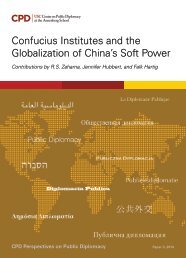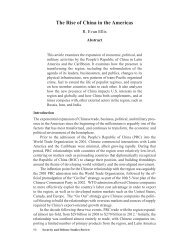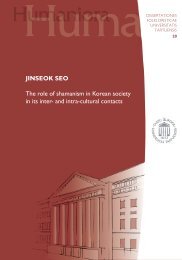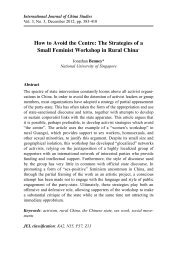JennyChan.PhDThesis.2014.FINAL
JennyChan.PhDThesis.2014.FINAL
JennyChan.PhDThesis.2014.FINAL
Create successful ePaper yourself
Turn your PDF publications into a flip-book with our unique Google optimized e-Paper software.
markets on the part of local governments has led to an overwhelming emphasis on<br />
firm autonomy and flexibility at the expense of workers’ safety, health and rights.” 138<br />
To ensure a good investment climate, local labor officials do not stringently enforce<br />
labor laws and regulations. They are far more interested in creating a<br />
business-friendly environment for building their political career. Based on his survey,<br />
Barry Naughton found that “cadres are subject to annual evaluations, in which they<br />
can score up to 100 points, of which more than 70 are awarded for outcomes that are<br />
directly linked to economic growth.” 139 Not surprisingly, labor inspection by the<br />
local bureaucracy is to a large extent a systemic failure.<br />
The fundamental right to strike was included in China’s 1975 and 1978 Constitutions,<br />
but was eventually removed in 1982, reflecting the government leaders’ concerns<br />
over political stability and their fear of the possible influence of Polish Solidarity on<br />
Chinese activists. 140 Strikers are thus not protected by Chinese law. But the absence<br />
of legislative protection has failed to curtail workers from going on strike. 141<br />
Whereas strikes tend to have a more “immediate political effect than do such<br />
‘nibbling’ actions as absenteeism, pilfering, slowdowns, or sabotage,” 142 scholars<br />
have also paid attention to labor court challenges 143 and collective worker<br />
petitions, 144 which likewise have drawn great attention from state officials at various<br />
138 Mary Elizabeth Gallagher, 2004, “Time is Money, Efficiency is Life: The Transformation of Labor<br />
Relations in China,” Studies in Comparative International Development 39(2), p. 20.<br />
139 Barry Naughton, 2010, “China’s Distinctive System: Can It Be a Model for Others?”, Journal of<br />
Contemporary China 19(65), p. 455.<br />
140 Jeanne L. Wilson, 1990, “‘The Polish Lesson:’ China and Poland 1980-1990,” Studies in<br />
Comparative Communism XXIII (3/4), p. 267.<br />
141 Chris King-Chi Chan, 2010, The Challenge of Labour in China: Strikes and the Changing Labour<br />
Regime in Global Factories, London: Routledge; Ching Kwan Lee, 2010, “Pathways of Labor<br />
Activism,” Chinese Society: Change, Conflict and Resistance, edited by Elizabeth J. Perry and Mark<br />
Selden, London: Routledge, pp. 57-79; Ching Kwan Lee, 2007, Against the Law: Labor Protests in<br />
China’s Rustbelt and Sunbelt, Berkeley: University of California Press; Anita Chan, 2011, “Strikes in<br />
China’s Export Industries in Comparative Perspective,” The China Journal 65 (January), pp. 27-51;<br />
Feng Chen, 2007, “Individual Rights and Collective Rights: Labor’s Predicament in China,”<br />
Communist and Post-Communist Studies 40, pp. 59-79.<br />
142 Elizabeth J. Perry, 1993, Shanghai on Strike: The Politics of Chinese Labor, Stanford, California:<br />
Stanford University Press, p. 7.<br />
143 Isabelle Thireau and Hua Linshan, 2003, “The Moral Universe of Aggrieved Chinese Workers:<br />
Workers’ Appeals to Arbitration Committees and Letters and Visits Offices,” The China Journal 50<br />
(July), pp. 83-103; Mary E. Gallagher, 2006, “Mobilizing the Law in China: ‘Informed<br />
Disenchantment’ and the Development of Legal Consciousness,” Law and Society Review 49(4), pp.<br />
783-816; Mary E. Gallagher and Baohua Dong, 2011, “Legislating Harmony: Labor Law Reform in<br />
Contemporary China,” From Iron Rice Bowl to Informalization: Markets, Workers, and the State in a<br />
Changing China, edited by Sarosh Kuruvilla, Ching Kwan Lee and Mary E. Gallagher, Ithaca, NY:<br />
Cornell University Press, pp. 36-60; Feng Chen and Xin Xu, 2012, “‘Active Judiciary’: Judicial<br />
Dismantling of Workers’ Collective Action in China,” The China Journal 67 (January), pp. 87-107.<br />
144 On a vivid study of migrant worker petitions to local and Beijing governments, see, Globalization<br />
Monitor, 2009, o Choice but to Fight: A Documentation of Chinese Battery Women Workers’<br />
Struggle for Health and Dignity, Hong Kong: Globalization Monitor, ch. 5.<br />
36






